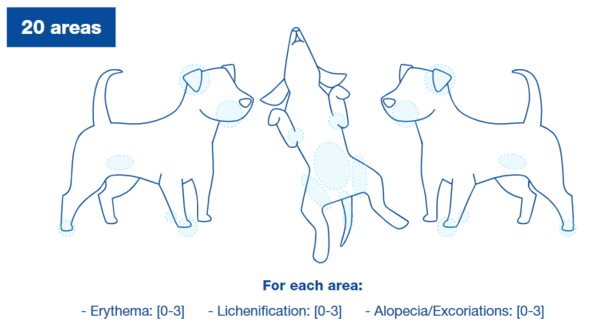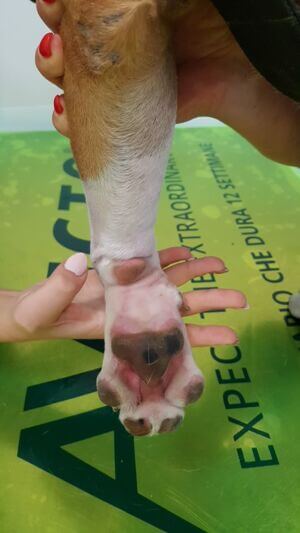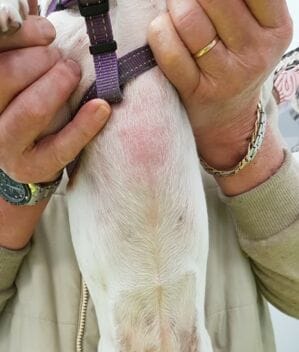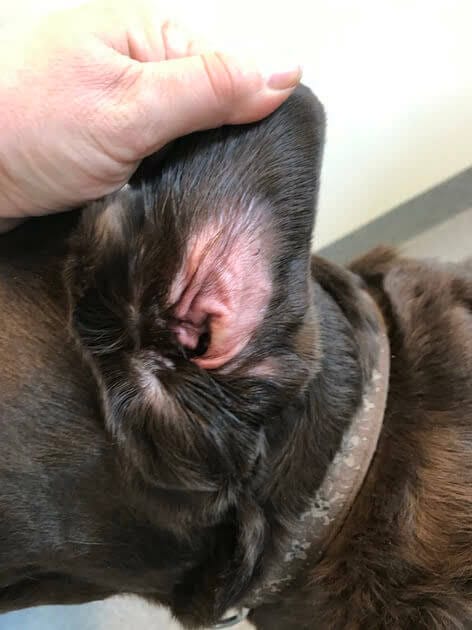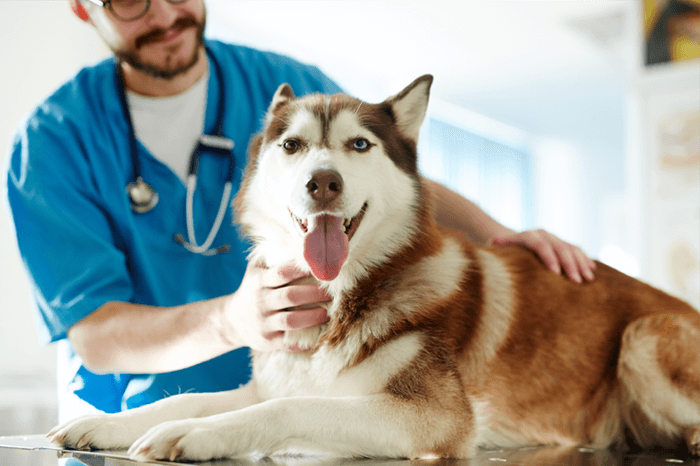Everything you need to know about dog allergies
Emelie Fogelberg Veterinary surgeonAllergies in dogs are really common. It is a lifelong disease that can affect your dog’s and your family’s quality of life. Understanding the disease and how to manage it will is really important
Allergies in dogs are remarkably common. They may cause a range of different signs and symptoms that can alter your pet’s quality of life, and be caused by a vast array of different substances in the environment. In fact, we can say that each dog’s allergy profile is as unique as they are! However, that doesn’t mean that there aren’t a number of common factors, many of which will respond well to some fairly straightforward management approaches.
How can you tell if your dog is allergic?
As humans, we tend to think of runny noses and swollen eyes when we think of allergies - because in humans, these are the most common symptoms. While this “allergic rhinitis” does occur in dogs, it’s actually pretty rare.
By far the most common symptoms in dogs are skin problems. These classically include notably the underside or belly, the groin, and the armpits, and often the paws and in between the toes. However, the exact locations vary dramatically, and can be quite different between breeds. On the picture are presented the most common location of allergic signs in dogs.
Common symptoms include:
Itching
Itchy skin has three major common causes: parasites (like fleas or mites), skin infections and skin allergies. And it’s a massive animal welfare issue: these dogs suffer from constant skin irritation, itching and soreness. And of course, that itching leads to…
Scratching and licking
It’s perfectly natural to want to scratch or lick an itch - in fact, the response might even have evolved to help protect us from parasites! But where there’s no parasite present, scratching repeatedly can be damaging. Vets call this “self-trauma”, and the injuries to the skin from repeated scratching will often lead to secondary skin infections - bacterial infections such as pyoderma, or yeast infections, typically with Malassezia. But the more often the skin is scratched and traumatised, the more inflammation is generated. In white or pale coloured dogs, you may notice the fur is locally a darker colour – this is from saliva staining, from repeated licking
Redness and inflammation
Inflammation of the skin causes an increase in blood flow to the area, causing it to change colour, becoming red and angry-looking. The problem is that the scratching may cause further inflammation, but inflammation is itchy, leading to more scratching, and leaving the skin even more inflamed - and so on and so on. We sometimes call this the “Itch-Scratch Cycle”.
Hair loss
Repeated self-trauma will commonly result in hair loss, as the hairs are pulled out and the follicles destroyed by inflammation and scratching, leading to bald patches as illustrated just above.
Flaky skin
Some dogs present with dry, flaky skin (dandruff), either locally in case of localised inflammation or more wide-spread on the whole body.
Skin changes
In the long term, repeated inflammation and damage to the skin causes it to thicken and darken (sometimes called “lichenification”). This is an attempt by the skin to protect itself and is a marker of a serious and long-term skin problem.
We may also see papules - small red “bumps” or marks on or in the skin.
Ear disease
Yes, you read that right! Remember, the ear is lined with skin, and actually ears are a really good marker of skin health: in the ear, mild allergic inflammation rapidly progresses to secondary bacterial or yeast infections. These can easily be treated, but the underlying condition is still there. As a result, we often consider that a young dog who has repeated ear infections for no obvious reason is at high risk of developing full blown allergic skin disease later in life.
What causes dog allergies?
We can consider an allergy to be a “mistake” by the dog’s immune system. Although very powerful, the immune system isn’t infallible and can sometimes start attacking things it isn’t supposed to, or doesn’t need to. When the immune system attacks healthy body cells by mistake, we call this an auto-immune disease. When, however, it misidentifies a harmless substance (such as a pollen, or a cleaning substance) as harmful, we see the result as an allergy.
Allergens: the triggers for dog allergies...
An allergen is just a harmless substance that the immune system has recognised as a target. And there are a huge range of different allergens that different dogs will respond to.
Common allergens include:
- Flea saliva: We call this Flea Allergic Dermatitis or FAD, and many dogs will react aggressively to this!
- Environmental allergens including pollens, moulds and surface proteins from mites (many dogs develop allergic reactions to harmless storage and dust mites).
- Food allergy: It’s important to remember that food allergies in dogs is not the most common allergy, but where food allergies do occur, it’s usually an allergy to proteins (in meat in the majority of cases). Another important misconception is that food allergies in dogs cause gastrointestinal upsets - actually, this is very rare, and most dog food allergies result in the same itchy sore skin that other allergens do.
...penetrating the dog’s barriers and causing inflammation...
In allergic dogs, there are alterations to the microbial skin barrier, so the natural “good” bacteria are less diverse and less protective. The mechanical skin barrier is also less effective, allowing allergens to penetrate more easily. We also see failure of the mechanical barrier as a result of skin trauma - so that repeated scratching can actually make the allergies worse, by introducing more allergen to the immune cells, fuelling the fire. This immune system, however, appears not to work as effectively in predisposed dogs, and the skin immune barrier is more reactive than in other dogs, causing it to react more rapidly and aggressively, and not to “calm down” so readily. Unlike in humans, though, in dogs histamine from mast cells is less important, which explains why antihistamine medications are usually much less effective in dogs with allergies than in humans.
These chemicals trigger changes in the local tissues - increased blood flow, movement of white blood cells, and changes in nerve sensation - triggering the pain, itching, redness and other changes we see.
Breed Disposition
Although any breed (or mixed-breed) can suffer, there are certain breeds that are more predisposed to developing allergies, such as West Highland White Terriers, Golden Retrievers, Labrador Retrievers, Shar Peis, Dalmatians, Boxers and Boston Terriers to name a few! Age of onset tends to be in the younger years, typically between 6 months and 3 years of age. If the symptoms didn’t appear until later middle age (over 6 years), then it’s quite likely that there’s some other issue involved.
How to diagnose dog allergies?
Determining that a dog has allergies is relatively straightforward, if sometimes slow. However, working out what the dog is allergic to is rather harder.
Diagnosis of allergic skin disease is often a long, drawn-out process and can be very frustrating. However, this is by far the best way to get to a definite diagnosis so that you and your vet know exactly what’s going on and how to address it!
Unfortunately, there is no simple test for allergic skin disease in dogs: blood and skin tests can help to determine what a dog is allergic to, but cannot by themselves in most cases say if a dog is allergic or not. The diagnosis of dog allergies is a case of carefully ruling out other conditions and then thorough examination of the symptoms and history.
First, rule out parasites and skin infection
This step may seem unnecessary - or even insulting. However, it’s absolutely essential that the most common cause of itching is ruled out at the beginning: fleas and other parasites! To this end, the vet may well recommend a change in flea or parasite treatment. This isn’t a criticism of you, and nor is the vet saying they don’t believe you - but until these are ruled out, the diagnosis will always be uncertain.
The vet may also do coat brushings for signs of fleas, and skin scrapes for mites such as Sarcoptic Mange or Demodectic Mange.
A skin test may be done by your vet to check if your dog is suffering from a skin infection. If yes, this has to be treated before investigating further.
Once these have been ruled out, we move on to the next step.
Recent changes
Have there been any recent changes in washing powder, food, bedding etc.? It usually takes about 6 weeks before a change manifests as an allergy, it’s not right away, but a complete change in laundry detergent (say) followed 6 weeks later by the development of symptoms is quite suspicious.
However, sadly, in most cases these changes turn out not to be relevant, and so we go on to the next approach.
Food allergies
Diagnosing food allergies is complicated, as most food allergies do not cause simple changes on blood or skin tests. Instead, a Dietary Exclusion Trial is needed. The dog is taken off their normal diet (completely - including treats, edible training aids and snacks), and placed onto either a hydrolysed diet (which the immune system cannot respond to) or a novel source diet (which the immune system hasn’t ever seen before, e.g. tapioca and salmon). They then stay on that diet ONLY for 8-12 weeks. If there is no improvement, it almost certainly wasn’t a food allergy. If there is an improvement, we then do the scary thing - we start reintroducing normal foods, and see what triggers a reaction.
Environmental allergies
In the case of environmental allergies (pollens, moulds, etc.), blood and skin tests can be useful (although be very cautious of any tests that aren’t performed by your veterinarian, as sadly there are a lot of “fake tests” out there). There is also the possibility of the dog testing positive for one allergen, but actually responding to something different in a “real world” situation, so these tests are best interpreted by your vet or even a specialist veterinary dermatologist.
Once we know what allergens the dog is responding to, we can start to think about long-term treatment.
How are dog allergies managed?
As a general rule of thumb, do not try to treat even moderate allergic skin disease in dogs yourself - always talk to your vet for advice! Treatment will depend on what’s causing the allergy and is likely to evolve over time, and is often a combination of solutions. If not managed appropriately, the symptoms can rapidly worsen and become much more difficult to control.
There are four basic approaches that we can take to manage dog allergies:
- Avoid the allergens where possible (e.g. frequent cleaning to minimise dust mites, regular preventative flea control, avoiding certain foods or cleaning products)
- Topical approach to bring soothing ingredients where needed
- Drugs to reduce itching and skin inflammation
- Increase immune intolerance
What is the prognosis of allergies in dogs?
Allergies are a lifelong disease that require lifetime management. It’s important to remember that most allergies in dogs require multiple different approaches at the same time to get on top of them and keep them controlled. And as we’ve seen, no two dogs are identical: every dog’s allergies are unique to them, and so the treatment must also be unique. There is no single solution for every dog. In any case, bringing active ingredients such as Ophytrium contained in DOUXO® S3 CALM at high concentration directly on the skin is beneficial to soothe, strengthen and equilibrate the skin.
We recommend
Our solution for itchy, irritated and sensitive skins.
DOUXO® S3 CALM soothes itchy, irritated and sensitive skin while balancing skin microbiota which is commonly unbalanced in sensitive skins. It helps to protect the skin barrier ecosystem from allergens and improves skin hydration.

